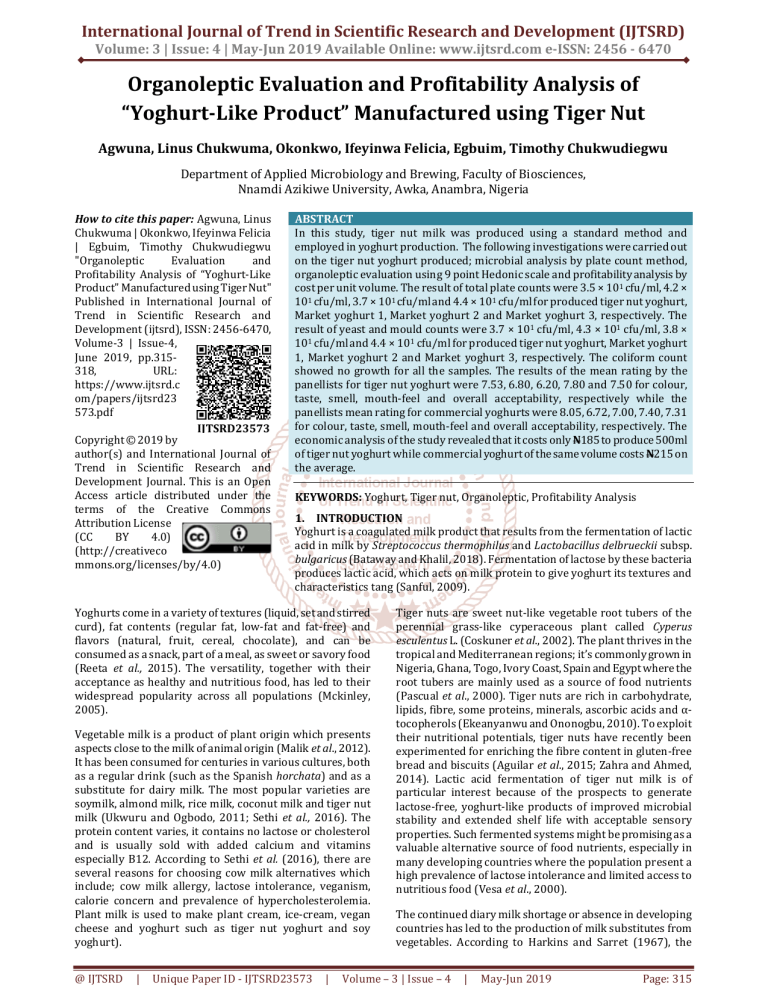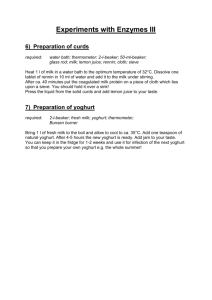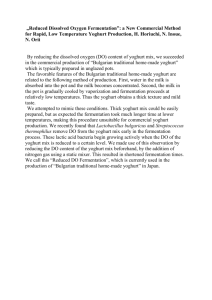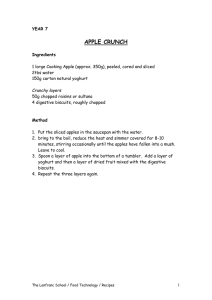
International Journal of Trend in Scientific Research and Development (IJTSRD)
Volume: 3 | Issue: 4 | May-Jun 2019 Available Online: www.ijtsrd.com e-ISSN: 2456 - 6470
Organoleptic Evaluation and Profitability Analysis of
“Yoghurt-Like Product” Manufactured using Tiger Nut
Agwuna, Linus Chukwuma, Okonkwo, Ifeyinwa Felicia, Egbuim, Timothy Chukwudiegwu
Department of Applied Microbiology and Brewing, Faculty of Biosciences,
Nnamdi Azikiwe University, Awka, Anambra, Nigeria
How to cite this paper: Agwuna, Linus
Chukwuma | Okonkwo, Ifeyinwa Felicia
| Egbuim, Timothy Chukwudiegwu
"Organoleptic
Evaluation
and
Profitability Analysis of “Yoghurt-Like
Product” Manufactured using Tiger Nut"
Published in International Journal of
Trend in Scientific Research and
Development (ijtsrd), ISSN: 2456-6470,
Volume-3 | Issue-4,
June 2019, pp.315318,
URL:
https://www.ijtsrd.c
om/papers/ijtsrd23
573.pdf
IJTSRD23573
Copyright © 2019 by
author(s) and International Journal of
Trend in Scientific Research and
Development Journal. This is an Open
Access article distributed under the
terms of the Creative Commons
Attribution License
(CC
BY
4.0)
(http://creativeco
mmons.org/licenses/by/4.0)
ABSTRACT
In this study, tiger nut milk was produced using a standard method and
employed in yoghurt production. The following investigations were carried out
on the tiger nut yoghurt produced; microbial analysis by plate count method,
organoleptic evaluation using 9 point Hedonic scale and profitability analysis by
cost per unit volume. The result of total plate counts were 3.5 × 101 cfu/ml, 4.2 ×
101 cfu/ml, 3.7 × 101 cfu/ml and 4.4 × 101 cfu/ml for produced tiger nut yoghurt,
Market yoghurt 1, Market yoghurt 2 and Market yoghurt 3, respectively. The
result of yeast and mould counts were 3.7 × 101 cfu/ml, 4.3 × 101 cfu/ml, 3.8 ×
101 cfu/ml and 4.4 × 101 cfu/ml for produced tiger nut yoghurt, Market yoghurt
1, Market yoghurt 2 and Market yoghurt 3, respectively. The coliform count
showed no growth for all the samples. The results of the mean rating by the
panellists for tiger nut yoghurt were 7.53, 6.80, 6.20, 7.80 and 7.50 for colour,
taste, smell, mouth-feel and overall acceptability, respectively while the
panellists mean rating for commercial yoghurts were 8.05, 6.72, 7.00, 7.40, 7.31
for colour, taste, smell, mouth-feel and overall acceptability, respectively. The
economic analysis of the study revealed that it costs only N185 to produce 500ml
of tiger nut yoghurt while commercial yoghurt of the same volume costs N215 on
the average.
KEYWORDS: Yoghurt, Tiger nut, Organoleptic, Profitability Analysis
1. INTRODUCTION
Yoghurt is a coagulated milk product that results from the fermentation of lactic
acid in milk by Streptococcus thermophilus and Lactobacillus delbrueckii subsp.
bulgaricus (Bataway and Khalil, 2018). Fermentation of lactose by these bacteria
produces lactic acid, which acts on milk protein to give yoghurt its textures and
characteristics tang (Sanful, 2009).
Yoghurts come in a variety of textures (liquid, set and stirred
curd), fat contents (regular fat, low-fat and fat-free) and
flavors (natural, fruit, cereal, chocolate), and can be
consumed as a snack, part of a meal, as sweet or savory food
(Reeta et al., 2015). The versatility, together with their
acceptance as healthy and nutritious food, has led to their
widespread popularity across all populations (Mckinley,
2005).
Vegetable milk is a product of plant origin which presents
aspects close to the milk of animal origin (Malik et al., 2012).
It has been consumed for centuries in various cultures, both
as a regular drink (such as the Spanish horchata) and as a
substitute for dairy milk. The most popular varieties are
soymilk, almond milk, rice milk, coconut milk and tiger nut
milk (Ukwuru and Ogbodo, 2011; Sethi et al., 2016). The
protein content varies, it contains no lactose or cholesterol
and is usually sold with added calcium and vitamins
especially B12. According to Sethi et al. (2016), there are
several reasons for choosing cow milk alternatives which
include; cow milk allergy, lactose intolerance, veganism,
calorie concern and prevalence of hypercholesterolemia.
Plant milk is used to make plant cream, ice-cream, vegan
cheese and yoghurt such as tiger nut yoghurt and soy
yoghurt).
@ IJTSRD
|
Unique Paper ID - IJTSRD23573
|
Tiger nuts are sweet nut-like vegetable root tubers of the
perennial grass-like cyperaceous plant called Cyperus
esculentus L. (Coskuner et al., 2002). The plant thrives in the
tropical and Mediterranean regions; it’s commonly grown in
Nigeria, Ghana, Togo, Ivory Coast, Spain and Egypt where the
root tubers are mainly used as a source of food nutrients
(Pascual et al., 2000). Tiger nuts are rich in carbohydrate,
lipids, fibre, some proteins, minerals, ascorbic acids and αtocopherols (Ekeanyanwu and Ononogbu, 2010). To exploit
their nutritional potentials, tiger nuts have recently been
experimented for enriching the fibre content in gluten-free
bread and biscuits (Aguilar et al., 2015; Zahra and Ahmed,
2014). Lactic acid fermentation of tiger nut milk is of
particular interest because of the prospects to generate
lactose-free, yoghurt-like products of improved microbial
stability and extended shelf life with acceptable sensory
properties. Such fermented systems might be promising as a
valuable alternative source of food nutrients, especially in
many developing countries where the population present a
high prevalence of lactose intolerance and limited access to
nutritious food (Vesa et al., 2000).
The continued diary milk shortage or absence in developing
countries has led to the production of milk substitutes from
vegetables. According to Harkins and Sarret (1967), the
Volume – 3 | Issue – 4
|
May-Jun 2019
Page: 315
International Journal of Trend in Scientific Research and Development (IJTSRD) @ www.ijtsrd.com eISSN: 2456-6470
development of milk substitutes extracted from cereals and
legumes serve as an alternative way of producing acceptable
nutritious food based on vegetables. Although yoghurts are
produced in Nigeria, the need for cost-effective major raw
material for yoghurt production as well as lactose-free
yoghurt-like products cannot be overemphasized. The high
cost of cow milk has led to explorations on local substrates
that will serve as major raw material for yoghurt production.
Considering the economic situation of the country, there is a
need for the adoption of local and cheap materials for
products that are cheaper and readily available for general
consumption.
2. MATERIALS AND METHODS
Sample Collection
Tiger nut for milk production was purchased from Eke-Awka
market in Awka, Anambra State.
Starter cultures Streptococcus thermophilus and Lactobacillus
bulgaricus were purchased from Onitsha main market,
Anambra State.
Equipment and Reagents
Processing facilities which include homogenizer, water bath,
Waring blender, refrigerator and other equipment, as well as
reagents, were provided by the Department of Applied
Microbiology and Brewing, Nnamdi Azikiwe University,
Awka, Anambra State, Nigeria.
Milk Extraction Method
The extraction of milk (Figure 1) was carried out by the
modification of the traditional method of milk extraction as
described by Ofori-Anti (2000). One kilogram (1kg) of tiger
nut was milled with 2000ml of distilled water in a Waring
blender at high speed for 10 minutes. The milk slurry was
pressed through cheesecloth; the milk obtained was fortified
with 2g of glucose and was used for yoghurt production.
Raw Tubers
Washing
Soaking
Pressing
Cake
Milk
Figure: 1: Flow Diagram for milk production from
tiger nut tubers (Ofori-Anti, 2000).
Preparation of Yogurt
The tiger nut milk was filtered of impurities using
cheesecloth. The temperature of the milk was gradually
increased to 80oC for 60 min to ensure proper
pasteurization. Pasteurized tiger nut milk was rapidly cooled
to 44oC for purpose of starter culture addition; 5g of starter
culture was added and stirred for 4 min. Thereafter,
sterilized bottle jar with a tight seal was filled with milk and
incubated in a water bath at 44oC for 4 h until complete
coagulation. Manufactured yoghurt was stored in a
refrigerator at 5oC as described by Tamime and Robinson
(1985).
|
Unique Paper ID - IJTSRD23573
Organoleptic Evaluation
The overall acceptability of tiger nut yoghurt manufactured
was carried out by 20 panellists according to the method
described by Sameen et al. (2016). Appearance, colour, taste,
smell, mouth-feel and general acceptability ranking were
assessed for organoleptic evaluation; the mean of the
manufactured yoghurt and of three popular market yoghurts
was taken. The organoleptic evaluation was done using 9
point Hedonic scale. The ratings were as shown below:
Rating Acceptability
Like extremely
Like very much
Like moderately
Like slightly
Neither like nor dislike
Dislike slightly
Dislike moderately
Dislike very much
Dislike extremely
Score
9
8
7
6
5
4
3
2
1
Profitability Analysis
Profitability analysis was carried out to ascertain the cost of
producing a 500ml bottle of the yoghurt and those of some
popular yoghurts of the same quantity in the market.
The cost of the following was found and recorded:
1. Tiger nut per kilogram
2. Flavour used (Vanilla) per ml
3. Sucrose sugar per gram
4. Cost of water per 2 litres
5. Cost of other inputs used
Wet Milling
@ IJTSRD
Microbiological Analysis
Microbiological analysis was done on the tiger nut yoghurt
produced and purchased yoghurt samples to give an
indication of their microbial load. 5ml each of the produced
and market yoghurts were homogenized for 1 min in an
electromechanical homogenizer (Stomacher, Lab-blender
3500, Seward Medical, London, UK). Serial dilutions of the
samples were prepared for plating. Plate Count Agar (PCA)
was used for enumeration of total plate count and the plates
were incubated at 37°C for 24 h. Yeast Extract Agar (YEA)
was used for yeast and mould enumeration; the plates were
incubated at 25°C for 48 hours, according to Marshall
(1992). Violet Red Bile Agar was used for the enumeration of
coliforms and the plates were incubated at 37°C for 24 h,
according to Marshall (1992).
|
The total unit cost of producing 500ml of yoghurt using tiger
nut was compared to the mean cost of three commercial
yoghurts popular in the market.
3. RESULTS
Microbial Counts of Yoghurt Products
Table 1: Aerobic Plate Count-Total Viable Count of the
Finished Product and Market Yoghurts
Samples
Count(s) (Cfu/ml)
Produced tiger nut yoghurt
3.5 × 101
Market yoghurt 1
4.2 × 101
Market yoghurt 2
3.7 × 101
Market yoghurt 3
4.4 × 101
Volume – 3 | Issue – 4
|
May-Jun 2019
Page: 316
International Journal of Trend in Scientific Research and Development (IJTSRD) @ www.ijtsrd.com eISSN: 2456-6470
Table 2: Yeast and Mould Counts of the Finished
Product and Market Yoghurts
Samples
Count(s) (Cfu/ml)
Produced tiger nut yoghurt
3.7 × 101
Market yoghurt 1
4.3 × 101
Market yoghurt 2
3.8 × 101
Market yoghurt 3
4.4 × 101
Table 3: Coliform Counts of the Finished Product and
Market Yoghurt
Samples
Count(s) (Cfu/ml)
Produced tiger nut yoghurt
0
Market yoghurt 1
0
Market yoghurt 2
0
Market yoghurt 3
0
Results of Organoleptic Analysis
The panellists comprised of 40% women and 60% men,
majorly postgraduate students and staff of Department of
Applied Microbiology and Brewing, Nnamdi Azikiwe
University, Awka. Majority of them reported that they
consume yoghurt at least once in a month and just a few of
them reported that they consume yoghurt at least once every
S/N
Material
1
Tiger nut
week. The results of the organoleptic evaluation conducted
were shown in Table 4 as mean scores ± standard deviation.
Table 4: Organoleptic Evaluation of Tiger Nut Yoghurt
Produced and Market Yoghurts
Organoleptic
Tiger Nut
Market Yoghurt
Attributes
Yoghurt
(1,2and 3)
Colour
7.53b ±0.43
8.05a ± 0.34
Taste
6.80a±0.23
6.72a± 0.03
Smell
6.20b ±0.03
7.00a± 0.01
Mouth-feel
7.80a±0.41
7.40a± 0.34
Overall acceptability 7.50a±0.33
7.31a± 0.32
Key:
1. Results are means of twenty organoleptic scores ±
Standard deviation
2. Means in the same column with the same superscript
are not significantly different (p>0.05)
Profitability Analysis
Table 5 represents the total cost of raw materials purchased
for tiger nut yoghurt production and their unit price per
gram; this was to deduce the quantity and price of the raw
materials involved in producing 500ml of yoghurt.
Table 5: Prices of Materials for Yoghurt Production
Total Cost
Unit
Quantity
for 2 litres
price/500ml
1kg
N300
N75
Mean price of 3
market yoghurts
Other Ingredients
2
3
4
5
6
Starter culture (yogourmet)
Sugar
Flavour (vanilla)
Water
Packaging container
The total amount per 500ml
One packet(5g)
2g
5ml
2 litres
4 bottles (500ml each)
4. Discussion
Aerobic plate count is used as an indicator of bacterial
populations in a food sample (Belewu and Abodunrin, 2006).
The population of bacteria in the yoghurt samples ranged
from 3.5 × 101 to 4.4 × 101. Garbutt (1997) stated that
microbial count less than 30 colonies or less than 2.4 x 104
colony forming units per ml for the viable bacterial count in
a mixed culture is negligible or insignificant in food quality
and safety assessment, thus, the tiger nut yoghurts were
suitable for human consumption. The yeast and mould
counts for the samples did not exceed the microbiological
counts of 1.0 × 104 cfu/ml (Table 2) indicating that they were
safe for consumption. No coliforms were detected in the
samples, which is in accordance with the microbiological
standards (Table 3). This indicates that the samples were
within acceptable limit hence safe for consumption.
The organoleptic scores for tiger nut yoghurt produced in
comparison with commercial yoghurts in the market were
shown in Table 4; all the panellists rated the product
considerably high in almost all the attributes evaluated. The
result showed that the colour of the produced tiger nut
yoghurt recorded high mean score of 7.53 which translates
to “like moderately” on the 9-point hedonic scale while
commercial yoghurt recorded a mean score of 8.05 which
translates to “like very much” on the same scale. The colour
was based on how the appearance appealed to the panellists.
@ IJTSRD
|
Unique Paper ID - IJTSRD23573
|
N300
N20
N20
N20
N80
N75
N5
N5
N5
N20
N185
N215
There was a significant difference between the tiger nut
yoghurt and commercial yoghurt based on colour (p<0.05).
The rating for Taste followed almost the same trend as it has
a mean rating score of 6.80 while commercial yoghurt
recorded 6.72 which translates to “like moderately”. The
results showed that tiger nut yoghurt can give a good taste of
yoghurts. There was no significant difference between the
tiger nut yoghurt and commercial yoghurt based on taste
(p>0.05). The smell of the tiger nut yoghurt was also
accepted by the panellists as it recorded reasonable high
mean score of 6.20 which translates to “like slightly”,
although the commercial yoghurt recorded a higher mean
score of 7.0 which translate to “like moderately”. There was
a significant difference between the tiger nut yoghurt and
commercial yoghurt based on smell (p<0.05).
The score for mouth-feel recorded a high score of 7.80 which
translates to “like very much” compared to commercial
yoghurt that recorded a mean score of 7.40 which translates
to “like moderately” on the 9-point hedonic scale. There was
no significant difference between the tiger nut yoghurt and
commercial yoghurt based on mouth-feel (p>0.05). On the
general acceptability, tiger nut yoghurt was most preferred
as it had the highest mean score of 7.50 translating to “like
very much” while the commercial yoghurt had the mean
score of 7.31 translating to “like moderately”. Many of the
panellists after the evaluation declared interest to buy the
product if brought to the market. Results of the profitability
Volume – 3 | Issue – 4
|
May-Jun 2019
Page: 317
International Journal of Trend in Scientific Research and Development (IJTSRD) @ www.ijtsrd.com eISSN: 2456-6470
analysis showed that it costs only N185 to produce 500ml of
tiger nut yoghurt while commercial yoghurt of the same
volume cost N215 on average. The results of the study
showed that tiger nut yoghurts are more economical to
produce in comparison to commercial yoghurts produced
using cow milk.
5. CONCLUSION
Based on the findings of this work, it is concluded that
yoghurt production from tiger nut milk is feasible and could
be most appreciated by low-income earners and lactose
intolerant patients. Also, the product is safe for human
consumption and can compete favourably with commercial
yoghurts in terms of organoleptic evaluation and cost.
6. REFERENCES
[1] Aguilar, N., Albanell, E., Minarro, B., Guamis, B. and
Capellas, M. (2015). Effect of tiger nut-derived
products in gluten-free batter and bread. Food Science
and Technology International, 21: 323–331.
[2] Batawy, O. and Khalil, O. (2018). Manufacture and
properties of low-fat bio yoghurt containing probiotic
strains and maltodextrin as prebiotic. Journal of
Probiotics and Health, 6(1): 1-9.
[3] Belewu, M. A. and Abodunrin, O. A. (2006). Preparation
of kunnu from unexploited rich food source: Tiger nut
(Cyperus esculentus). World Journal of Dairy and Food
Sciences, 1(1): 19-21.
[4] Coskuner, Y., Ercan, R., Karababa, E. and Nazlıcan,
A.N.(2002). Physical and chemical properties
of
chufa (Cyperus esculentus L) tubers grown in the
Çukurova region of Turkey. Journal of the Science of
Food and Agriculture, 82: 625–631.
[5] Ekeanyanwu, R.C. andOnonogbu, C.I.(2010). Nutritive
value of Nigerian tiger nut (Cyperus esculentus L.).
Medwell Journals of Agriculture, 5: 297–302.
[6] Garbutt, J. (1997). Essentials of food microbiology.
London: Arnold Publishers. Pp. 103-245.
[7] Harkins, R.W. and Sarret, H. P. (1967). Methods of
comparing protein quality of soybean infant formulas
in rat. Journal of Nutrition, 91: 213-216.
[8] Malik, A. H., Anjum, F.M., Sameen, A., Khan, M.I. and
Sohaib, M. (2012). Extraction of starch from water
chestnut (TrapabispinosaRoxb) and its application in
yoghurt as a stabilizer. Pakistan Journal of Food Science,
22: 209–218.
@ IJTSRD
|
Unique Paper ID - IJTSRD23573
|
[9] Marshall, T. R. (1992). Standard method for the
examination of dairy product (16th ed). American
Public Health Association, Washington, D. C.
[10] Mckinley, M.C. (2005). The nutrition and health
benefits of yoghurt. International Journal of Dairy
Technology, 58 (1): 1-12.
[11] Ofori-Anti, A.O.(2000). Tiger nuts (Cyperus Esculentus):
production processing and product development.
issertation submitted to the Department of Nutrition
and Food Science, University of Ghana.
[12] Pascual, B., Maroto, J.V., LóPez-Galarza, Sa., Sanbautista,
A. and Alagarda, J.(2000). Chufa (Cyperus esculentus L.
var. sativus boeck.): An unconventional crop. Studies
related to applications and cultivation. Economic
Botany, 54: 439–448.
[13] Reeta, K. S., Ankita, J.and Ramadevi, N. (2015).
Fortification of yoghurt with health- promoting
additives: a review. Research and Reviews: Journal of
Food and Dairy
Technology, 3(3): 9-17.
[14] Sameen, A., Sattar, M.U., Javid, A., Ayub, A. and Khan,
M.I. (2016). Quality evaluation of
yoghurt stabilized
with sweet potato (Ipomoea batatas) and taro
(Colocasia esculenta) starch. International Journal of
Food and Allied Science, 2: 23–29.
[15] Sanful, R. E. (2009). The use of tiger-nut (Cyperus
esculentus), cow milk and their composite as
substrates for yoghurt production. Pakistan Journal
of Nutrition, 8: 755-758.
[16] Sethi, S., Tyagi, S. K. and Anurag, R. K. (2016). Plantbased milk alternatives an emerging segment
of
functional beverages: A review. Journal of Food Science
and Technology, 53(9): 3408-3423.
[17] Tamime, A. Y. and Robinson, R.K. (1985). Yoghurt
science and technology. Oxford: Pergamon Press.
[18] Ukwuru, M.U. and Ogbodo, A.C.(2011). Effect of
processing treatment on the quality of tigernut milk.
Pakistan Journal of Nutrition, 10: 95–100.
[19] Vesa, T.H., Marteau, P. and Korpela, R.(2000). Lactose
intolerance. Journal of the American College
of
Nutrition, 19: 165–175.
[20] Zahra, S. and Ahmed, M.S.H.(2014). Exploring the
suitability of incorporating tiger nut flour
as novel
ingredient in gluten-free biscuit. Polish Journal of Food
and Nutrition Sciences, 64: 27–33.
Volume – 3 | Issue – 4
|
May-Jun 2019
Page: 318






